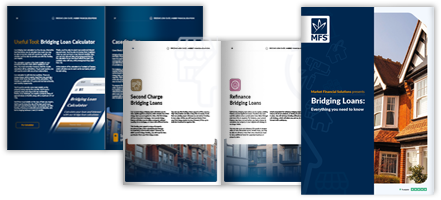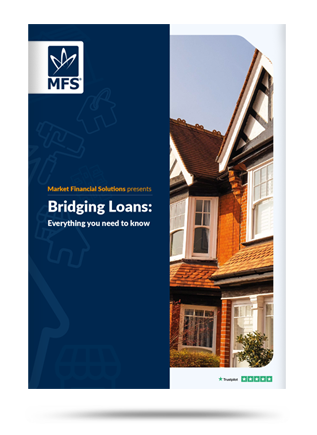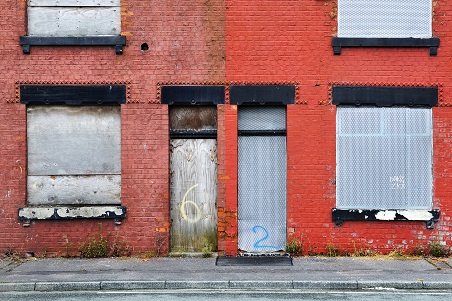
Written by Scott Lord
Deputy Chief Mortgage & Operations Officer – Front End
Market Financial Solutions are a bridging loan and buy-to-let mortgage provider and are not legal, financial, investment or tax advisers. This document is for informational purposes only and does not, and should not be considered, to constitute legal, financial, investment or tax advice or be relied upon by any person to make a legal, financial, investment or tax decision. Therefore, Investors are encouraged to seek appropriate professional advice. The information in this content is correct at time of writing.

Property chains are very common. To buy one property, many people must first sell another. But it can be difficult to align the dates such that both transactions can be completed on the same day. Alternatively, if you are planning on renovating a property, you may struggle to free up enough capital to complete the refurbishments. Also, if you have bought a property at an auction, it can be challenging to secure the funds within the 28-day completion period most auction houses stipulate. In all three of these cases, a bridging loan could help. However, many ask us: what is a bridging loan secured against?
As such, this blog will delve into the following topics:
- What is a bridging loan?
- How do secured loans work?
- What is the difference between a secured and an unsecured bridging loan?
- What is a bridging loan secured against?
- Are secured bridging loans regulated?
- What are the main advantages of secured bridging finance?
What Is a Bridging Loan?
Before we can answer the question ‘what is a bridging loan secured against?’, we must first define what a bridging loan is.
A bridge loan is a form of alternative finance that provides property investors with fast and flexible capital for their residential and commercial investments. These short-term loans can help bridge the gap between transactions, such as buying one property and selling another.
People or companies often use them to:
- Secure an asset while they arrange a long-term financial solution
- Bridge the gap between the sale and completion dates in a property chain
- Plan a quick turnaround on a renovation project
- Buy properties at auction
The length of a bridge loan can vary depending on your bridging lender. Our loans are available from 3 to 24 months.
How Do Decured Loans Work?
So now, we need to explore the concept of a ‘secured loan’. For the majority of secured loans, they are secured against property or land the loan will be used to purchase. But other assets may also be used as security. What’s accepted will vary between lenders.
On the whole, lenders prefer secured loans to be first charge – the principal loan on a property or asset. But, it’s still possible to secure a second charge or third charge bridging loan. Yet the latter options often come with higher rates and lower loan to value (LTV) ratios. This is because they pose more risk for a lender, which finds itself down the pecking order for repayments.
Most commonly used when buying a new home, residential bridging loans are secured against property in which the borrower will soon be renting out to tenants. These are usually used to minimise the risk of being caught up in a long property chain.
In terms of the alternative forms of security, there are a range of other assets that some lenders will accept:
- Commercial equipment and machinery
- High value vehicles
- Jewellery and watches
- Artwork
- Boats and yachts
That list is by no means exhaustive. So, it is worthwhile speaking with a broker or industry expert with in-depth knowledge of bridging financing. They can advise you if you require specialised products and have valuable assets you’d like to use as security.

What Is a Bridging Loan Secured Against?
With this in mind, bridging loans are typically secured against the asset being purchased or renovated. In the buy to let market, this means a property that a landlord is purchasing, renovating or securing at auction, will be used as the collateral in the deal.
Unlike a mortgage, bridge loans are not directly linked to the borrower’s income. To repay the loan, the borrower would need to sell the property, sell another property or asset, or raise long-term finance to pay it back. Indeed, when taking out a bridge loan, lenders often require details about an exit plan.
In other words, they will want to know how a borrower plans to pay back the loan before they provide the capital. This could include evidence that a mortgage will be forthcoming, or that sale plans are progressing.
What Is the Difference Between a Secured and an Unsecured Loan?
So, how is a secured loan different to an unsecured loan? In short, an unsecured loan requires no collateral, but interest and fees are often still charged. Some examples of these loans include student loans, personal loans, and credit card debt.
With no collateral involved, eligibility for these loans is typically based on the borrowers’ credit score and history of debt repayments. Generally, they also involve higher interest rates than a secured loan.
Are They Regulated?
Bridge loans can be both regulated and unregulated. A regulated bridging loan is typically secured against property that the borrower already owns, intends to own, and/or plans to live in.
The main difference between a regulated and an unregulated loan, in this sense, is that a regulated loan is not being used for business or commercial purposes. These loans are generally used when there is a break in the property chain and the buyer needs to purchase the new property before selling the one they already own.
An unregulated bridge loan, on the other hand, would be used for the purposes of business. Indeed, the FCA rarely gets involved with contracts and commitments a business makes. This is because it is assumed that an organisation would know what they were doing and understood the risks.
Typically, these types of loans are used for the following purposes:
- Purchasing land for the purpose of getting planning permission
- Funding renovations to an investment property
- Securing property quickly
- Buying property at auction
- Flipping projects
- Refurbishments ahead of securing a buy-to-let mortgage
What Are the Main Advantages of a Secured Bridging Finance?
For one, bridge loans tend to be more accessible than most financial products. Given the unregulated nature of many secured bridging loans, there is generally less criteria for the borrower to meet. As such, borrowers with poor credit ratings or in complex financial situations can still access financial support.
Another benefit is that bridging loan repayments can be paid on a monthly basis. This is often seen as a more reasonable way of paying back the loan and its interest. Likewise, there is often a lack of an exit fee on secured bridging finance; this is particularly useful if a borrower repays the loan early.
They can also be used for a variety of purposes, as well as arranged as a second or third charge. This gives borrowers a lot of flexibility, which is harder to find in traditional lending institutions.
Check out our secured loan calculator to see how much you could borrow.
Why Choose Market Financial Solutions as Your Lender?
Market Financial Solutions is a well-established specialist lender. We have a 16-year track record in providing quality bridge loans. We have highly experienced underwriting staff who are specialists in complex circumstances. Therefore, we can react quickly and efficiently to any potential arising issues.
To help borrowers in unique or complex circumstances, we do not rely on a tick-box criteria for assessing enquiries. Instead, we take the applicant and the property into consideration by viewing their full picture and judging each case on its own individual merit. This means we can provide finance for those with adverse credit, CCJs, complex company structures or undervalued properties.
Speed is also one of our great strengths. We can turn enquiries around in as little as three days. Your rate will not be changed at any point during your bridging term and as we present all of our charges upfront – you can be sure there are no hidden fees.
The Complete Guide to
Bridging Loans
Everything you need to know
- Different bridging types
- Useful tools
- Apply them in real life
- Market insights & more





